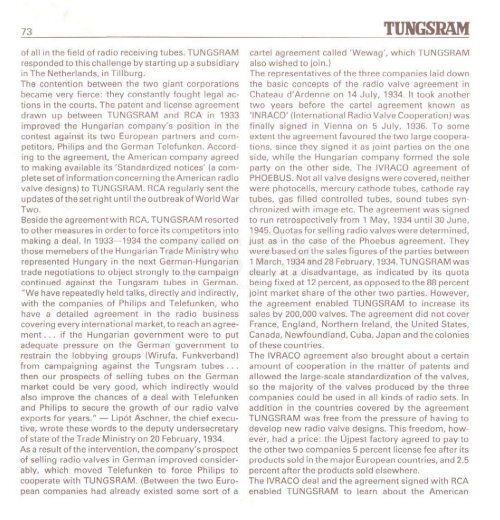THE HISTORY OF TUNGSRAM 1896-1945 - MEK
THE HISTORY OF TUNGSRAM 1896-1945 - MEK
THE HISTORY OF TUNGSRAM 1896-1945 - MEK
- No tags were found...
Create successful ePaper yourself
Turn your PDF publications into a flip-book with our unique Google optimized e-Paper software.
73 <strong>TUNGSRAM</strong>of all in the field of radio receiving tubes. <strong>TUNGSRAM</strong>responded to this challenge by starting up a subsidiaryin The Netherlands, in Tillburg.The contention between the two giant corporationsbecame very fierce: they constantly fought legal actionsin the courts. The patent and license agreementdrawn up between <strong>TUNGSRAM</strong> and RCA in 1933improved the Hungarian company's position in thecontest against its two European partners and competitors,Philips and the German Telefunken. Accordingto the agreement, the American company agreedto making available its 'Standardized notices' (a completeset of information concerning the American radiovalve designs) to <strong>TUNGSRAM</strong>. RCA regularly sent theupdates of the set right until the outbreak of World WarTwo.Beside the agreement with RCA, <strong>TUNGSRAM</strong> resortedto other measures in orderto force its competitors intomaking a deal. In 1933—1934 the company called onthose memebers of the Hungarian Trade Ministry whorepresented Hungary in the next German-Hungariantrade negotiations to object strongly to the campaigncontinued against the Tungsram tubes in German."We have repeatedly held talks, directly and indirectly,with the companies of Philips and Telefunken, whohave a detailed agreement in the radio businesscovering every international market, to reach an agreement... if the Hungarian government were to putadequate pressure on the German government torestrain the lobbying groups (Wirufa, Funkverband)from campaigning against the Tungsram tubes . . .then our prospects of selling tubes on the Germanmarket could be very good, which indirectly wouldalso improve the chances of a deal with Telefunkenand Philips to secure the growth of our radio valveexports for years." — Lipot Aschner, the chief executive,wrote these words to the deputy undersecretaryof state of the Trade Ministry on 20 February, 1934.As a result of the intervention, the company's prospectof selling radio valves in German improved considerably,which moved Telefunken to force Philips tocooperate with <strong>TUNGSRAM</strong>. (Between the two Europeancompanies had already existed some sort of acartel agreement called 'Wewag', which <strong>TUNGSRAM</strong>also wished to join.)The representatives of the three companies laid downthe basic concepts of the radio valve agreement inChateau d'Ardenne on 14 July, 1934. It took anothertwo years before the cartel agreement known as'INRACO' (International Radio Valve Cooperation) wasfinally signed in Vienna on 5 July, 1936. To someextent the agreement favoured the two large cooperations,since they signed it as joint parties on the oneside, while the Hungarian company formed the soleparty on the other side. The IVRACO agreement ofPHOEBUS. Not all valve designs were covered, neitherwere photocells, mercury cathode tubes, cathode raytubes, gas filled controlled tubes, sound tubes synchronizedwith image etc. The agreement was signedto run retrospectively from 1 May, 1934 until 30 June,<strong>1945</strong>. Quotas for selling radio valves were determined,just as in the case of the Phoebus agreement. Theywere based on the sales figures of the parties between1 March, 1934 and 28 February, 1934. <strong>TUNGSRAM</strong> wasclearly at a disadvantage, as indicated by its quotabeing fixed at 12 percent, as opposed to the 88 percentjoint market share of the other two parties. However,the agreement enabled <strong>TUNGSRAM</strong> to increase itssales by 200,000 valves. The agreement did not coverFrance, England, Northern Ireland, the United States,Canada, Newfoundland, Cuba, Japan and the coloniesof these countries.The IVRACO agreement also brought about a certainamount of cooperation in the matter of patents andallowed the large-scale standardization of the valves,so the majority of the valves produced by the threecompanies could be used in all kinds of radio sets. Inaddition in the countries covered by the agreement<strong>TUNGSRAM</strong> was free from the pressure of having todevelop new radio valve designs. This freedom, however,had a price: the Ujpest factory agreed to pay tothe other two companies 5 percent license fee after itsproducts sold in the major European countries, and 2.5percent after the products sold elsewhere.The IVRACO deal and the agreement signed with RCAenabled <strong>TUNGSRAM</strong> to learn about the American








![Letöltés egy fájlban [4.3 MB - PDF]](https://img.yumpu.com/50159926/1/180x260/letaltacs-egy-fajlban-43-mb-pdf.jpg?quality=85)







